Europe Museums, Historical Sites, Zoos, And Parks Market Size
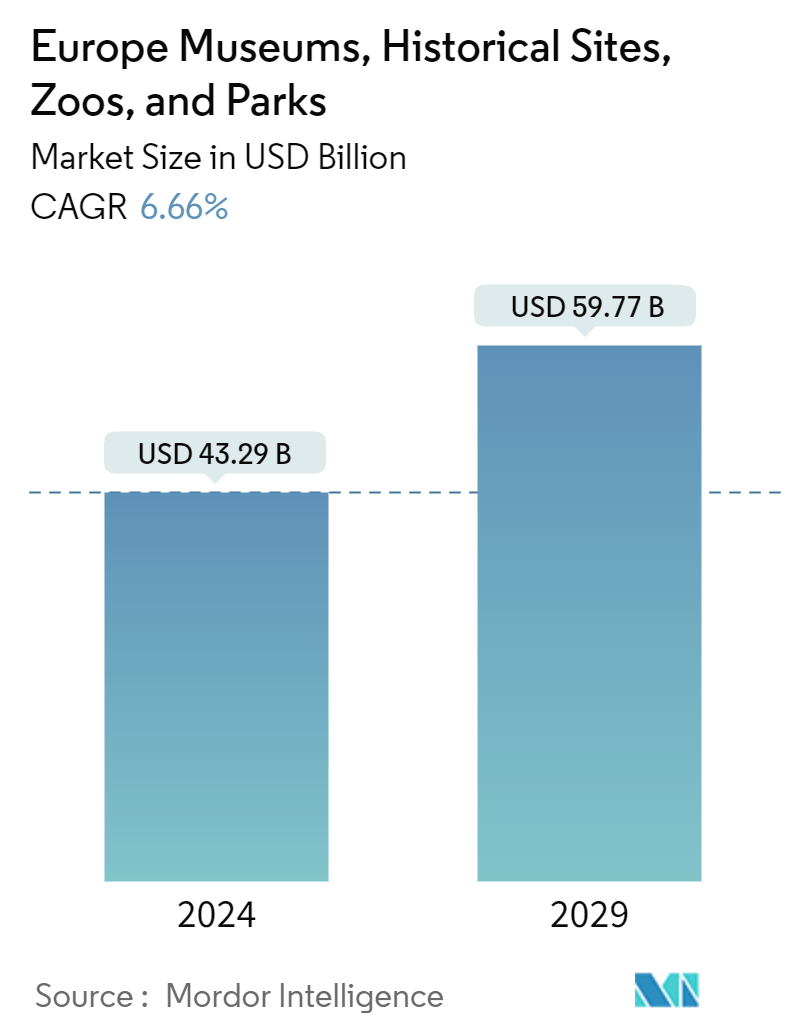
| Study Period | 2020 - 2029 |
| Base Year For Estimation | 2023 |
| Market Size (2024) | USD 43.29 Billion |
| Market Size (2029) | USD 59.77 Billion |
| CAGR (2024 - 2029) | 6.66 % |
| Market Concentration | Medium |
Major Players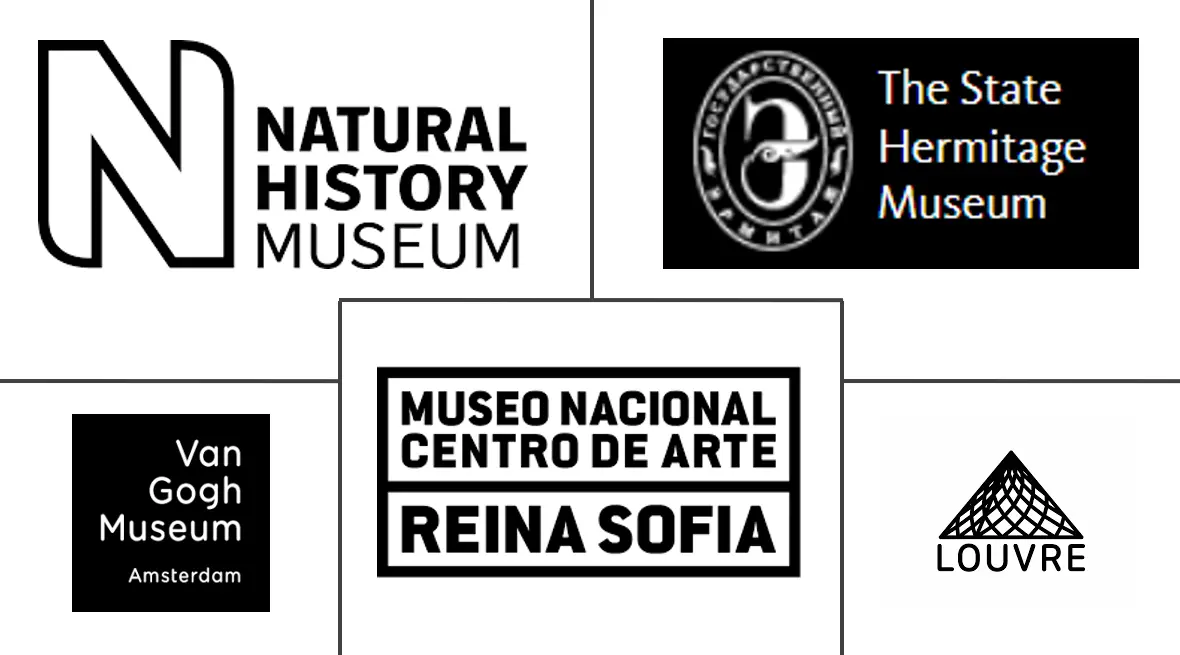
*Disclaimer: Major Players sorted in no particular order |
Europe Museums, Historical Sites, Zoos, And Parks Market Analysis
The Europe Museums, Historical Sites, Zoos, And Parks Market size is estimated at USD 43.29 billion in 2024, and is expected to reach USD 59.77 billion by 2029, growing at a CAGR of 6.66% during the forecast period (2024-2029).
The market is set for significant expansion, fuelled by institutions' integration of digital innovations to stay pertinent in the digital era. This entails facilitating virtual exploration of exhibits and delivering educational experiences to individuals, including students who may be unable to venture outside their classrooms.
A major driver of market growth is the relaxation of governmental restrictions worldwide, leading to an uptick in visitor numbers to museums, historical sites, zoos, and parks. Additionally, the adoption of digital technologies enhances the accessibility of these attractions, amplifying their reach beyond physical boundaries and catering to a broader audience base. Furthermore, the surge in global travel activity indirectly contributes to market expansion, as tourists seek cultural enrichment and wildlife experiences.
Furthermore, zoos are adapting to evolving societal attitudes and ethical concerns regarding animal welfare. Efforts are underway to reshape visitor experiences by prioritizing the well-being of animals. Various zoos are implementing innovative concepts, such as the Philadelphia Zoo's zoo360 initiative, which includes features like the Big Cat crossing. These changes align with the advocacy for animal rights and contribute to the sustainability and relevance of zoos in the modern era.
In conclusion, the market is witnessing dynamic growth fuelled by factors such as the adoption of digitalization, relaxation of restrictions, and evolving approaches to animal welfare. By considering these trends and implementing innovative strategies, institutions can ensure their continued relevance and appeal to visitors in the years ahead.
Europe Museums, Historical Sites, Zoos, And Parks Market Trends
Rise in the Number of Visitors to Museums is Driving the Market
Europe's status as a favored tourist destination draws millions of visitors annually, many of whom include museums in their cultural itinerary. This trend contributes to the uptick in museum attendance. To attract visitors, museums frequently organize special events, exhibitions, and educational programs. These efforts not only enhance the visitor experience but also expand the museum's audience. Additionally, there is a rising enthusiasm for culture and history among the general populace, motivating more individuals to visit museums to delve into art, artifacts, and exhibitions
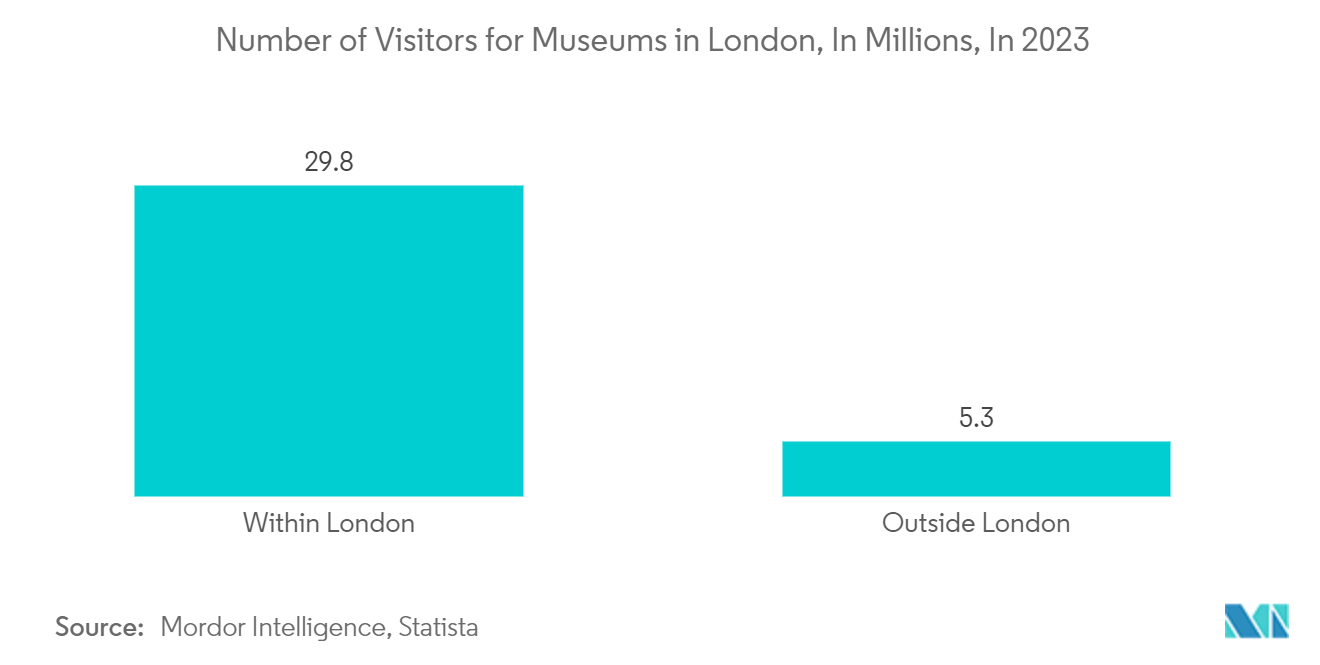
Digitalization is Driving the Market
As an alternative to traditional guides, pre-recorded audio guides are frequently utilized in museums and art galleries. These guides allow visitors to interact with extra, expanded, and unbiased information. Visitors are given multimedia content transmitters, including audio guides with pre-recorded audio files in the chosen language, headsets, earbuds, or headphones. These audio guides serve as extra sources of income for event planners and are accessible at any time by a huge number of people. They are also available in many languages and translated versions.
These audio tours for museums increase visitor interaction, increase accessibility, and offer more detailed information to educate visitors objectively. With approximately 8 million annual visitors, the Louvre Museum in France has implemented audio tours to provide interactive content about the artwork. The British Museum in London, the San Francisco Museum of Modern Art, and the Auckland War Memorial Museum in New Zealand are further museums that provide visitors with taped audio guides.
Using augmented reality (AR) technology, art galleries, museums, and zoos provide visitors with a genuine experience. The real-time integration of digital information with the user's environment is known as augmented reality. By creating a visual tour guide and presenting 3D material from a real-world camera perspective, museums and zoos now employ augmented reality to educate and entertain the audience.
For instance, the Cleveland Museum of Art uses augmented reality technology to enable people to interact with and obtain the most up-to-date and thorough information about each piece of art on display. The group employed augmented reality (AR) technology to bring a collection of architectural and sculptural remnants to life in the Acropolis Museum in Athens, Greece.
Moreover, In 2022, 98.5 percent of England's museums and art galleries used some form of online communication within the year. Overall, 85 percent of these establishments reported having used Facebook. By contrast, just five percent of institutions had used mobile applications that year.
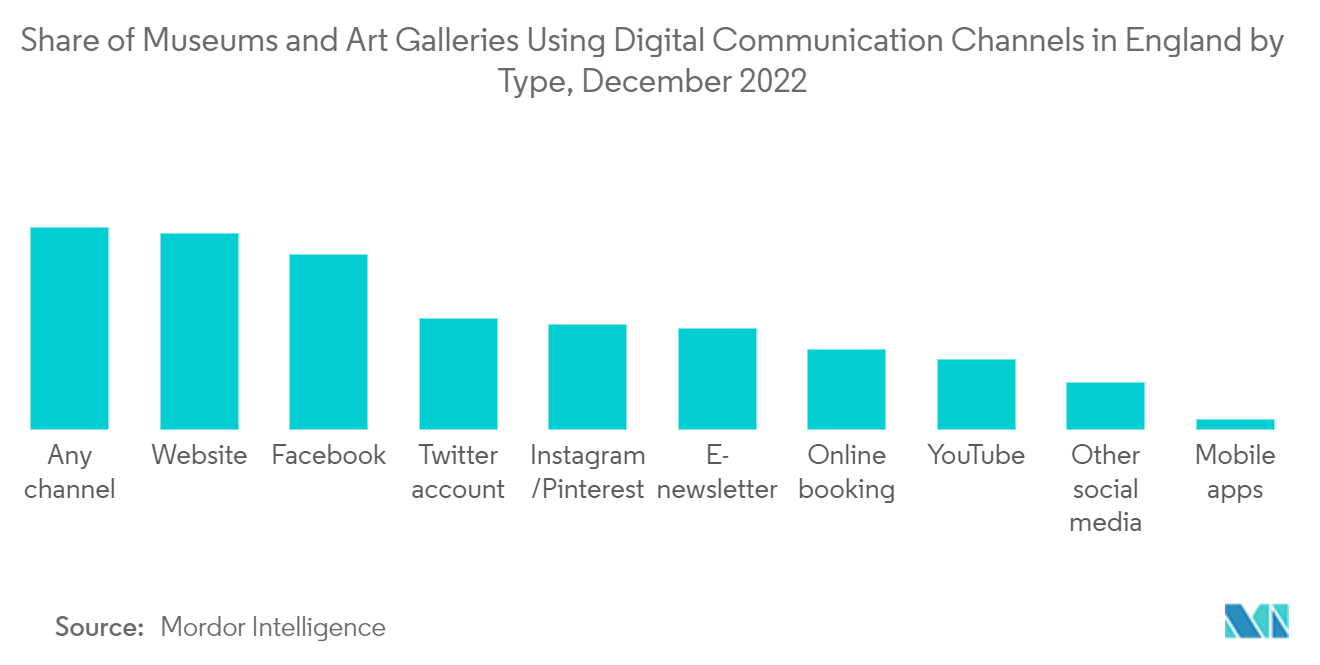
Europe Museums, Historical Sites, Zoos, And Parks Industry Overview
The market is expected to be concentrated with a large number of players. Some of the major players present in the market are Louvre, Paris; State Hermitage, St Petersburg; Reina Sofia, Madrid; Vatican Museums, Vatican; State Tretyakov Gallery, Moscow; Natural History Museum, London; Centre Pompidou, Paris; British Museum, London; Museo Nacional Del Prado, Madrid; Van Gogh Museum, Amsterdam; among others. The market is expected to remain competitive over the forecasted period.
Europe Museums, Historical Sites, Zoos, And Parks Market Leaders
-
Louvre, Paris
-
State Hermitage, St Petersburg
-
Reina Sofia, Madrid
-
Natural History Museum, London
-
Van Gogh Museum, Amsterdam
*Disclaimer: Major Players sorted in no particular order
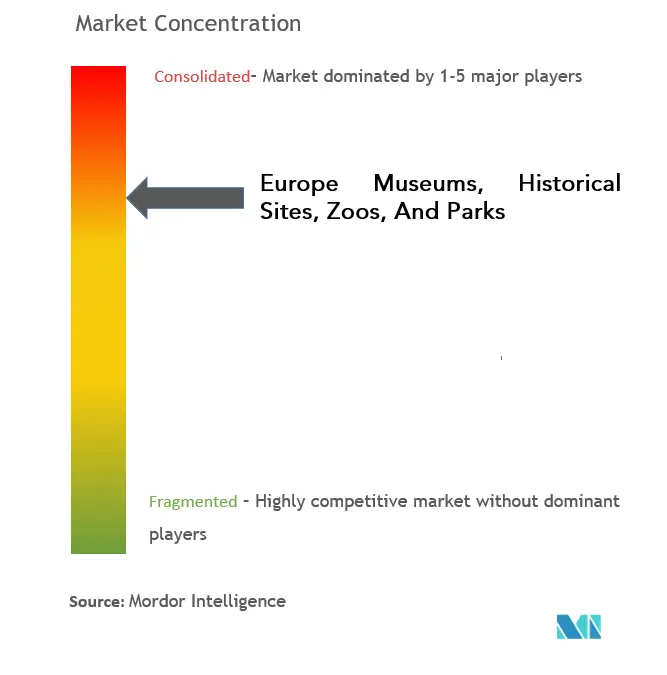
Europe Museums, Historical Sites, Zoos, And Parks Market News
- March 2023: Young V&A will open its doors in Bethnal Green for the summer holidays after a project that has seen it be transformed from its former iteration as the V&A Museum of Childhood.
- September 2022: The Museum of Homelessness (MoH) announced plans to open its first location at Manor House Lodge in London's Finsbury Park. It will be developed in collaboration with residents and community groups. Workshops, talks, and performances will be held at the museum, developed by those who have experienced homelessness. An open-access art studio for those who are homeless is also included in the designs.
Europe Museums, Historical Sites, Zoos, And Parks Market Report - Table of Contents
1. INTRODUCTION
- 1.1 Study Assumptions and Market Definition
- 1.2 Scope of the Study
2. RESEARCH METHODOLOGY
3. EXECUTIVE SUMMARY
4. MARKET DYNAMICS AND INSIGHTS
- 4.1 Market Overview
-
4.2 Market Drivers
- 4.2.1 Rise in the Number of Visitors to Museums is Driving the Market
- 4.2.2 Digitalization is Driving the Market
-
4.3 Market Restraints
- 4.3.1 Maintenance and Preservation Costs
- 4.3.2 Changing Visitor Preferences
-
4.4 Opportunities
- 4.4.1 Digital Engagement and Virtual Experiences
- 4.4.2 Cultural Heritage Preservation
- 4.5 Value Chain Analysis
-
4.6 Industry Attractiveness: Porter's Five Forces Analysis
- 4.6.1 Threat of New Entrants
- 4.6.2 Bargaining Power of Buyers
- 4.6.3 Bargaining Power of Suppliers
- 4.6.4 Threat of Substitutes
- 4.6.5 Intensity of Competitive Rivalry
- 4.7 Insights into Technological Advancements in the Industry
- 4.8 Impact of COVID-19 on the Market
5. MARKET SEGMENTATION
-
5.1 By Type
- 5.1.1 Museums
- 5.1.2 Historical Sites
- 5.1.3 Zoos And Botanical Gardens
- 5.1.4 Nature Parks
- 5.1.5 Other Similar Institutions
-
5.2 By Revenue Source
- 5.2.1 Tickets
- 5.2.2 Food And Beverages
- 5.2.3 Other Revenue Souces
-
5.3 By Country
- 5.3.1 France
- 5.3.2 Germany
- 5.3.3 United Kingdom
- 5.3.4 Italy
- 5.3.5 Rest of Europe
6. COMPETITIVE LANDSCAPE
- 6.1 Market Concentration Overview
-
6.2 Company Profiles
- 6.2.1 Louvre, Paris
- 6.2.2 State Hermitage, St Petersburg
- 6.2.3 Reina Sofia, Madrid
- 6.2.4 Vatican Museums, Vatican
- 6.2.5 State Tretyakov Gallery, Moscow
- 6.2.6 Natural History Museum, London
- 6.2.7 Centre Pompidou, Paris
- 6.2.8 British Museum, London
- 6.2.9 Museo Nacional Del Prado, Madrid
- 6.2.10 Schonbrunner Zoo, Vienna
- 6.2.11 Pairi Daiza Zoo, Southern Belgium
- 6.2.12 Zoologischer Garten Berlin AG
- 6.2.13 Chester Zoo, England
- 6.2.14 Basel Zoo, Switzerland
- 6.2.15 Plitvice Lakes National Park
- 6.2.16 Durmitor*
- *List Not Exhaustive
7. MARKET OPPORTUNITIES AND FUTURE TRENDS
8. DISCLAIMER AND ABOUT US
** Subject To AvailablityEurope Museums, Historical Sites, Zoos, And Parks Industry Segmentation
A museum is where many one-of-a-kind and priceless goods, like historical artifacts or pieces of art, are maintained, examined, and presented to the general public. An official location where artifacts from social, political, or military history have been preserved for cultural heritage purposes is a historic site or heritage site. A zoo is a collection of wild animals kept in a park or garden for research, conservation, or public display. In contrast, a national park is a government-designated area for environmental preservation. Museums, Historical Sites, Zoos, And Parks report will cover insights into the world's Museums, Historical Sites, Zoos, And Parks sector, drivers, and market restraints. The report will also cover information on some of the major players active in the region.
Europe museums, historical sites, zoos, and parks are segmented by type, by revenue source, by geography. By type, the market is sub-segmented into museums, historical sites, zoos and botanical gardens, nature parks, and other similar institutions. By revenue source, the market is sub-segmented into tickets, food and beverages, and other revenue sources, and by geography market is segmented into France, Germany, United Kingdom, Italy, and Rest of Europe. The market sizes and forecasts for Europe museums, historical sites, zoos, and parks are provided in value (USD) for all the above segments.
| By Type | Museums |
| Historical Sites | |
| Zoos And Botanical Gardens | |
| Nature Parks | |
| Other Similar Institutions | |
| By Revenue Source | Tickets |
| Food And Beverages | |
| Other Revenue Souces | |
| By Country | France |
| Germany | |
| United Kingdom | |
| Italy | |
| Rest of Europe |
Europe Museums, Historical Sites, Zoos, And Parks Market Research Faqs
How big is the Europe Museums, Historical Sites, Zoos, And Parks Market?
The Europe Museums, Historical Sites, Zoos, And Parks Market size is expected to reach USD 43.29 billion in 2024 and grow at a CAGR of 6.66% to reach USD 59.77 billion by 2029.
What is the current Europe Museums, Historical Sites, Zoos, And Parks Market size?
In 2024, the Europe Museums, Historical Sites, Zoos, And Parks Market size is expected to reach USD 43.29 billion.
Who are the key players in Europe Museums, Historical Sites, Zoos, And Parks Market?
Louvre, Paris, State Hermitage, St Petersburg, Reina Sofia, Madrid, Natural History Museum, London and Van Gogh Museum, Amsterdam are the major companies operating in the Europe Museums, Historical Sites, Zoos, And Parks Market.
What years does this Europe Museums, Historical Sites, Zoos, And Parks Market cover, and what was the market size in 2023?
In 2023, the Europe Museums, Historical Sites, Zoos, And Parks Market size was estimated at USD 40.41 billion. The report covers the Europe Museums, Historical Sites, Zoos, And Parks Market historical market size for years: 2020, 2021, 2022 and 2023. The report also forecasts the Europe Museums, Historical Sites, Zoos, And Parks Market size for years: 2024, 2025, 2026, 2027, 2028 and 2029.
Europe Museums, Historical Sites, Zoos, And Parks Industry Report
Statistics for the 2024 Europe Museums, Historical Sites, Zoos, And Parks market share, size and revenue growth rate, created by Mordor Intelligence™ Industry Reports. Europe Museums, Historical Sites, Zoos, And Parks analysis includes a market forecast outlook to for 2024 to 2029 and historical overview. Get a sample of this industry analysis as a free report PDF download.



